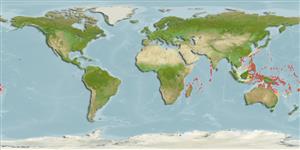Classification / Names
Common names from other countries
Main reference
Size / Weight / Age
Max length : 5.0 cm SL male/unsexed; (Ref. 48637)
Environment
Marine; reef-associated; depth range 2 - 18 m (Ref. 90102)
Climate / Range
Tropical, preferred ?
Distribution
Western Indian Ocean: Mozambique. Western Central Pacific: Indonesia, Philippines, Solomon Islands, and the Great Barrier Reef.
Countries | FAO areas | Ecosystems | Occurrences | Introductions
Short description
Dorsal
spines
(total): 7;
Dorsal
soft rays
(total): 7-8;
Anal
spines: 1;
Anal
soft rays: 8. Translucent, very finely dotted with red or black; two indistinct longitudinal rows of reddish dashes on back and one along lateral line; red line from upper lip to eye; a U-shaped reddish mark on each side of occiput behind eye (Ref. 27362). Caudal fin rounded (Ref. 27362); characterized further by having an extremely flattened head; unrestricted gill opening; unbranched 6-9 lowermost pectoral rays and thickened distally; longitudinal scale series 28-37; predorsal scales 10-13; depth of body at anus 5.1-9.4 in SL (Ref. 90102).
IUCN Red List Status (Ref. 115185)
Threat to humans
Harmless
Human uses
More information
Common namesSynonymsMetabolismPredatorsEcotoxicologyReproductionMaturitySpawningFecundityEggsEgg development
Age/SizeGrowthLength-weightLength-lengthLength-frequenciesMorphometricsMorphologyLarvaeLarval dynamicsRecruitmentAbundance
ReferencesAquacultureAquaculture profileStrainsGeneticsAllele frequenciesHeritabilityDiseasesProcessingMass conversion
Tools
Special reports
Download XML
Internet sources
Estimates of some properties based on models
Phylogenetic diversity index
PD50 = 1.0000 many relatives (e.g. carps) 0.5 - 2.0 few relatives (e.g. lungfishes)
Trophic Level
3.2 ±0.3 se; Based on size and trophs of closest relatives
Resilience
High, minimum population doubling time less than 15 months (Preliminary K or Fecundity.)
Vulnerability
Low vulnerability (13 of 100)
Price category
